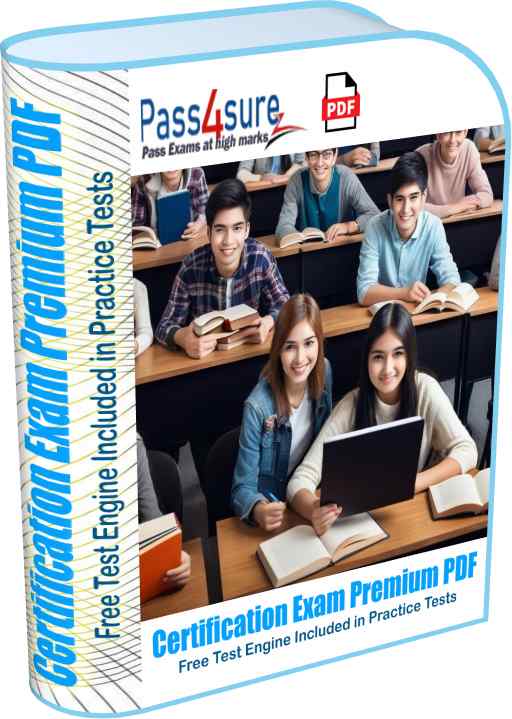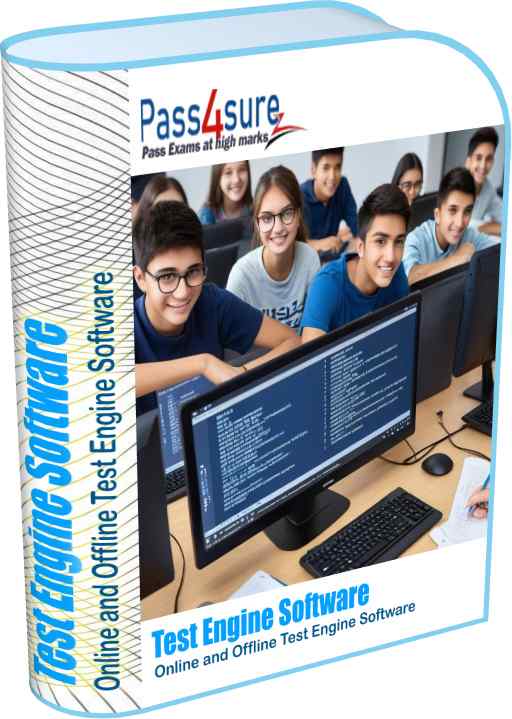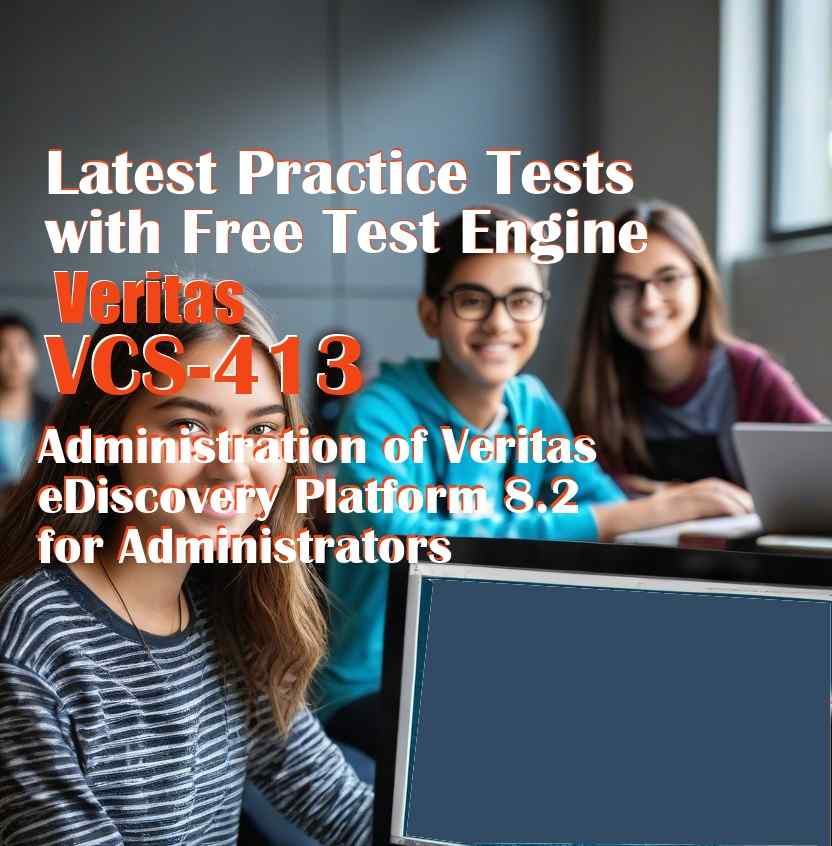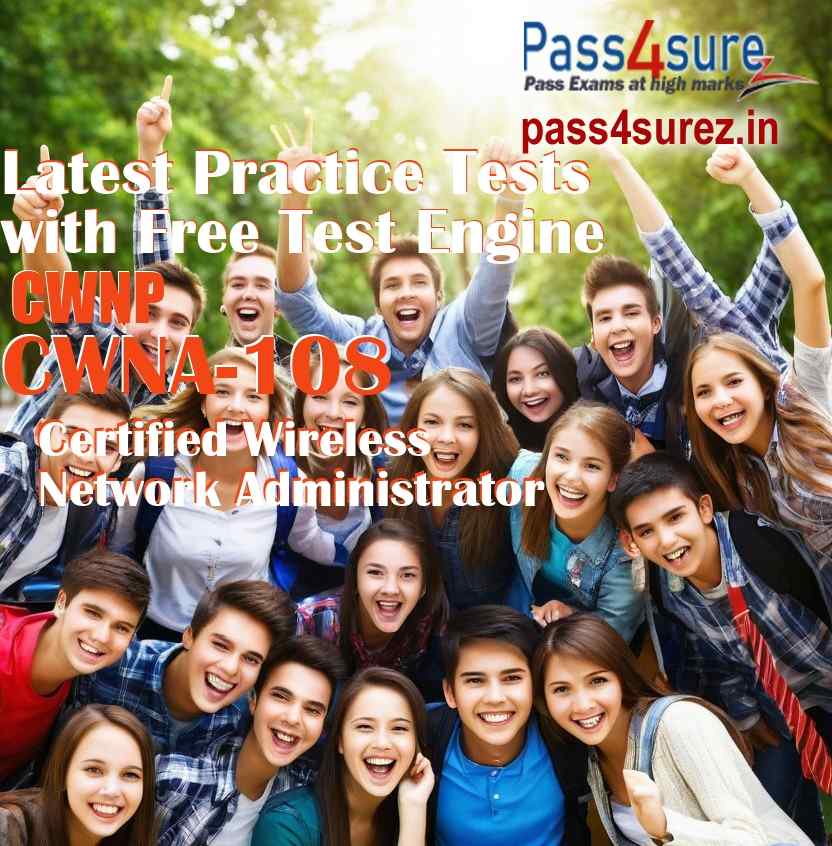| Exam Code | CWNA-108 |
| Questions and Answers | 60 |
| Premium Access | Yes |
| Online Test Engine | Yes |
| Comprehensive Q&A | Yes |
| Success Rate | 98% |
| Real Questions | Yes |
| Updated Regularly | Yes |
| Portable Files | ✔ |
| Unlimited Download | ✔ |
| 100% Secured | ✔ |
| Confidentiality | 100% |
| Success Guarantee | 100% |
| Any Hidden Cost | $0.00 |
| Auto Recharge | No |
| Updates Intimation | by Email |
| Technical Support | Free |
| PDF Compatibility | Windows, Android, iOS, Linux |
| Test Engine Compatibility | Mac/Windows/Android/iOS/Linux |
| Sample Questions |  |
Pass4sure Practice Tests are an effective way to prepare for the CWNA-108 exam. The practice tests include premium PDF and Test Engine Software. Pass4surez.in provides an extensive question bank to improve your knowledge and help you achieve high marks on the CWNA-108 exam.
The Certified Wireless Network Administrator exam questions and answers on Pass4surez.in are regularly verified and updated to ensure they reflect the latest syllabus and topics covered in the real test. The certification exams and entry test exams from pass4surez.com make you familiar with the test environment. The goal is to enhance your knowledge of the CWNA-108 exam and enable you to pass it on your first attempt.
The PDF of CWNA-108 exam questions and answers provided by Pass4surez.in contains a comprehensive pool of questions and verified answers, including references and explanations where applicable. The objective is not only to help you pass the exam, but also to significantly improve your knowledge of the latest CWNA-108 course topics.
 |
|
CERTIFICATION EXAM PREMIUM PDF
Pass4Sure provide premium PDF that contains all the questions and answers that are necessary to make your concepts about the exam topics clear and boost your knowledge about the exam. These questions and answers make you ready to face actual test in test centers. Our team keep on revising material and update the exam questions accordingly. You will feel confident in test center. Our support team keep on helping our customers to make their testing experience best. Our premium PDF files are searchable, convertable and printable at high quality to make book that you can study during traveling or during vacations. Our automated system sends intimation email to our customers on each update. The files in customer download section is overwritten with latest pdf files.
|
| |
|
 |
|
CERTIFICATION EXAM TEST ENGINE
Pass4sure test engine is best certification and examination preparation tool that help you make yourself ready to take the actual exam and get high marks in the exam. Our OTE (Online Test Engine) support all OS Platforms including iOS, Android, Windows, Linux, Chromebook etc and provide up to date experience to get ready for actual test. Our Offline Test Engine is compatible to all windows platforms including latest windows versions. Our test engines helps to familiarize actual test environment and makes you ready to take timed tests. Your performance history and graphs helps you to see when you are ready to sit in actual exam in test center. These test engines uses up to date and latest questions and answers, keeps on updating the questions pool and sends you intimation on each update.
|
Pass4sure Premium PDF and Test Engines support all platforms and devices including mobile devices and computers. You should download sample PDF and Test Engine to evaluate the product before you buy the full version. Our exam samples include some questions that may be or may not be up to date but full version is always up to date.
EXAM NUMBER : CWNA-108
EXAM NAME : Certified Wireless Network Administrator
QUESTIONS TYPE : Multiple-Choice
PASSING SCORES : 70%
The CWNA certification is a foundational level wireless LAN certification for the CWNP Program. To earn a CWNA certification, you must take the CWNA exam at a Pearson Vue Testing Center and pass with a 70% or higher. Instructors must pass with a 80% or higher. However you choose to prepare for the CWNA exam, you should start with the exam objectives, which cover the full list of skills tested on the exam. The CWNA certification is valid for three (3) years. To recertify, pass one of the professional level certifications exams (CWSP,CWDP, CWAP) BEFORE your CWNA expires. By doing so, the CWNA will be renewed for another three (3) years. Or retake the current version of the CWNA exam.
While the Certified Wireless Specialist (CWS) and Certified Wireless Technician (CWT) certifications are not a required prerequisite to the CWNA certification, it is highly recommended. It will provide a solid learning foundation before continuing to pursue the CWNA.
Main Areas Covered by CWNA:
- Radio Frequency (RF) Technologies
- Antenna Concepts
- Wireless LAN Hardware and Software
- Network Design, Installation, and Management
- Wireless Standards and Organizations
- 802.11 Network Architecture
- Wireless LAN Security
- Troubleshooting
The Certified Wireless Network Administrator (CWNA) understands standards and operations
of 802.11 wireless networks. Responsibilities include deploying, managing, monitoring, and
basic troubleshooting of these networks. The CWNA has the ability to describe devices and
operations of current WLAN technologies.
The CWNA exam has no prerequisites; however, the following are recommended before
attempting the CWNA exam:
● Basic knowledge of networking (routers, switches, cabling, etc.)
● Basic knowledge of TCP/IP
● At least 1 year of work experience with wireless LAN technologies
The skills and knowledge measured by this examination are derived from a Job Task Analysis
(JTA) involving wireless networking experts (CWNEs) and professionals. The results of this JTA
were used in weighing the subject areas and ensuring that the weighting is representative of the
relative importance of the content.
When you pass the CWNA exam, you earn credit towards the CWSP, CWDP, CWAP, and
CWNE certifications and you earn the CWNA certification.
The following chart provides the breakdown of the exam as to the distribution of questions
within each knowledge domain
- Radio Frequency (RF) Technologies 15%
- WLAN Regulations and Standards 20%
- WLAN Protocols and Devices 20%
- WLAN Network Architecture and Design Concepts 15%
- WLAN Network Security 10%
- RF Validation 10%
- WLAN Troubleshooting 10%
1.0 Radio Frequency (RF) Technologies – 15%
1.1 Define and explain the basic characteristics of RF and RF behavior
• Wavelength, frequency, amplitude, phase, sine waves
• RF propagation and coverage
• Reflection, refraction, diffraction and scattering
• Multipath and RF interference
• Gain and loss
• Amplification
• Attenuation
• Absorption
• Voltage Standing Wave Ratio (VSWR)
• Return Loss
• Free Space Path Loss (FSPL)
1.2 Apply the basic concepts of RF mathematics and measurement
• Watt and milliwatt
• Decibel (dB)
• dBm and dBi
• Noise floor
• SNR
• RSSI
• dBm to mW conversion rules of 10 and 3
• Equivalent Isotropically Radiated Power (EIRP)
1.3 Identify RF signal characteristics as they relate to antennas.
• RF and physical line of sight and Fresnel zone clearance
• Beamwidths
• Passive gain
• Polarization
• Antenna diversity types
• Radio chains
• Spatial multiplexing (SM)
• Transmit Beamforming (TxBF)
• Maximal Ratio Combining (MRC)
• MIMO
1.4 Explain and apply the functionality of RF antennas, antenna systems, and accessories available
• Omni-directional antennas
• Semi-directional antennas
• Highly directional antennas
• Reading Azimuth and Elevation charts for different antenna types
• Antenna orientation
• RF cables and connectors
• Lightning arrestors and grounding rods/wires
2.0 WLAN Regulations and Standards – 20%
2.1 Explain the roles of WLAN and networking industry organizations
• IEEE
• Wi-Fi Alliance
• IETF
• Regulatory domains and agencies
2.2 Explain and apply the various Physical Layer (PHY) solutions of the IEEE 802.11-2016
standard as amended including supported channel widths, spatial streams, data rates.
• DSSS – 802.11
• HR-DSSS – 802.11b
• OFDM – 802.11a
• ERP – 802.11g
• Wi-Fi 4 - HT – 802.11n
• Wi-Fi 5 - VHT – 802.11ac
• Wi-Fi 6 - HE - 802.11ax
2.3 Understand spread spectrum technologies, Modulation and Coding Schemes (MCS)
• DSSS
• OFDM
• OFDMA and Resource Units
• BPSK
• QPSK
• QAM (16, 64, 256,1024)
2.4 Identify and apply 802.11 WLAN functional concepts
• Primary channels
• Adjacent overlapping and non-overlapping channels
• Throughput vs. data rate
• Bandwidth
• Guard Interval
2.5 Describe the OSI model layers affected by the 802.11-2016 standard and amendments
2.6 Identify and comply with regulatory domain requirements and constraints (specifically
in 2.4 GHz and 5 GHz)
• Frequency bands used by the 802.11 PHYs
• Available channels
• Regulatory power constraints
• Dynamic Frequency Selection (DFS)
• Transmit Power Control (TPC)
2.7 Explain basic use case scenarios for 802.11 wireless networks
• Wireless LAN (WLAN) – BSS and ESS
• Wireless bridging
• Wireless Ad-Hoc (IBSS)
• Wireless Mesh
3.0 WLAN Protocols and Devices – 20%
3.1 Describe the components and functions that make up an 802.11 wireless service set
• Stations (STAs)
• Basic Service Set (BSS) (Infrastructure mode)
• SSID
• BSSID
• Extended Service Set (ESS)
• IBSS (Ad-Hoc)
• Distribution System (DS)
• Distribution System Media (DSM)
3.2 Define terminology related to the 802.11 MAC and PHY
• MSDU, MPDU, PSDU, and PPDU
• A-MSDU and A-MPDU
• PHY preamble and header
3.3 Identify and explain the MAC frame format
• MAC frame format
• MAC addressing
3.4 Identify and explain the purpose of the three main 802.11 frame types
• Management
• Control
• Data
3.5 Explain the process used to locate and connect to a WLAN
• Scanning (active and passive)
• Authentication
• Association
• Open System Authentication and Shared Key authentication
• Connecting to 802.1X/EAP and Pre-Shared Key authentication networks
• BSS selection
• Connecting to hidden SSIDs
3.6 Explain 802.11 channel access methods
• DCF
• EDCA
• RTS/CTS
• CTS-to-Self
• NAV
• Interframe spaces (SIFS, DIFS, EIFS, AIFS)
• Physical carrier sense and virtual carrier sense
• Hidden node
3.7 Explain 802.11 MAC operations
• Roaming
• Power save modes and frame buffering
• Protection mechanisms
3.8 Describe features of, select, and install WLAN devices, control, and management
systems
• Access Points (APs)
• WLAN controllers
• Wireless network management systems
• Wireless bridge and mesh APs
• Client devices
4.0 WLAN Network Architecture and Design Concepts– 15%
4.1 Describe and implement Power over Ethernet (PoE) 802.3af, 802.3at, 802.3bt
• Power Source Equipment
• Powered Device
• Midspan and endpoint PSEs
• Power classes to include power differences between PSE and PD
• Power budgets and powered port density
4.2 Define and describe differences, advantages and constraints of the different wireless
LAN architectures
• Centralized data forwarding
• Distributed data forwarding
• Control, Management and Data planes
• Scalability and availability solutions
• Tunneling, QoS and VLANs
4.3 Describe design considerations for common deployment scenarios in wireless such as
coverage requirements, roaming considerations, throughput, capacity and security
• Design considerations for data
• Design considerations for voice
• Design considerations for video
• Design considerations for location services including Real-Time Location
Services (RTLS)
• Design considerations for highly mobile devices (e.g. tablets and smartphones)
• Capacity planning for high and very high-density environments
• Design considerations for guest access/BYOD
• Design considerations for supporting legacy 802.11 devices
4.4 Demonstrate awareness of common proprietary features in wireless networks.
• AirTime Fairness
• Band steering
• Dynamic power and channel management features
4.5 Determine and configure required network services supporting the wireless network
• DHCP for client addressing, AP addressing and/or controller discovery
• DNS for address resolution for clients and APs
• Time synchronization protocols (e.g. NTP, SNTP)
• VLANs for segmentation
• Authentication services (e.g. RADIUS, LDAP)
• Access Control Lists for segmentation
• Wired network capacity requirements
5.0 WLAN Network Security – 10%
5.1 Identify weak security options that should not be used in enterprise WLANs
• WEP
• Shared Key authentication
• SSID hiding as a security mechanism
• MAC filtering
• Use of deprecated security methods (e.g. WPA and/or WPA2 with TKIP)
• Wi-Fi Protected Setup (WPS)
5.2 Identify and configure effective security mechanisms for enterprise WLANs
• Application of AES with CCMP for encryption and integrity
• WPA2-Personal including limitations and best practices for pre-shared (PSK) use
• WPA2-Enterprise -configuring wireless networks to use 802.1X including
connecting to RADIUS servers and appropriate EAP methods
5.3 Understand basic concepts of WPA3 and Opportunistic Wireless Encryption (OWE) and
enhancements compared to WPA2
• Understand basic security enhancements in WPA3 vs. WPA2
• Understand basic security enhancements of encryption and integrity in WPA3
(e.g. CCMP, GCMP, AES)
• Simultaneous Authentication of Equals (SAE) in WPA3 as an enhancement for
legacy pre-shared key technology
• Understand the purpose of Opportunistic Wireless Encryption (OWE) for public
and guest networks
5.4 Describe common security options and tools used in wireless networks
• Access control solutions (e.g. captive portals, NAC, BYOD)
• Protected management frames
• Fast Secure Roaming methods
• Wireless Intrusion Prevention System (WIPS) and/or rogue AP detection
• Protocol and spectrum analyzers
• Best practices in secure management protocols (e.g. encrypted management
HTTPS, SNMPv3, SSH2, VPN and password management)
6.0 RF Validation – 10%
6.1 Verify and document that design requirements are met including coverage, throughput,
roaming, and connectivity with a post-implementation validation survey
6.2 Locate and identify sources of RF interference
• Identify RF disruption from 802.11 wireless devices including contention vs.
interference and causes/sources of both including co-channel contention (CCC),
overlapping channels, and 802.11 wireless device proximity
• Identify sources of RF interference from non-802.11 wireless devices based on the
investigation of airtime and frequency utilization
• Understand interference mitigation options including removal of interference
source or change of wireless channel usage
6.3 Perform application testing to validate WLAN performance
• Network and service availability
• VoIP testing
• Real-time application testing
• Throughput testing
6.4 Understand and use the basic features of validation tools
• Use of throughput testers for validation tasks
• Use of wireless validation software (specifically survey software and wireless
scanners)
• Use of protocol analyzers for validation tasks
• Use of spectrum analyzers for validation tasks
7.0 WLAN Troubleshooting – 10%
7.1 Describe and apply common troubleshooting tools used in WLANs
• Use of protocol analyzers for troubleshooting tasks
• Use of spectrum analyzers for identifying sources of interference
• Use of management, monitoring and logging systems for troubleshooting tasks
• Use of wireless LAN scanners for troubleshooting tasks
7.2 Identify and troubleshoot common wireless issues
• Identify causes of insufficient throughput in the wireless distribution systems
including LAN port speed/duplex misconfigurations, insufficient PoE budget,
and insufficient Internet or WAN bandwidth
• Identify and solve RF interference using spectrum analyzers
• Identify wireless performance issues using SNR, retransmissions, and airtime
utilization statistics
• Identify causes of wireless issues related to network services including DHCP,
DNS, and time protocols including using native interface and IP configuration
tools (e.g. pings, DNS lookups, interface configuration)
• Identify wireless issues related to security configuration mismatches
You can download a free PDF of the CWNA-108 practice test and study guide to try before purchasing the premium files. To ace the exam, simply download the CWNA-108 exam questions and answers file, memorize the content, and practice with the VCE Exam Simulator. This will ensure you are fully prepared for the real test.
The CWNA-108 PDF practice test and exam questions and answers can be accessed on any device, including iPhone, iPad, Android, and Windows. You can download the PDF to your computer or any other device and start studying. Additionally, you can download and install the VCE Exam Simulator for further practice. The CWNA-108 PDF is printable in high quality, allowing you to take it with you on vacations or while traveling. Your updated CWNA-108 exam files can be accessed anytime from your online account, and you will receive your login credentials immediately after purchase.


